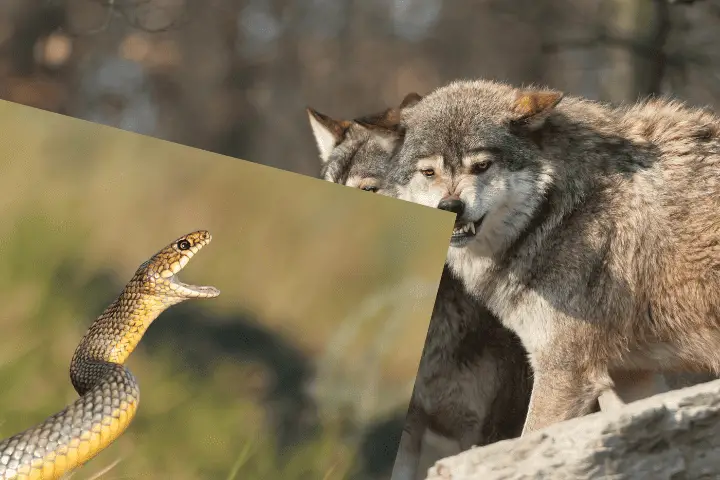Do Wolves Eat Snakes
Wolves, being carnivores, typically consume meat such as deer or elk. But, there is limited evidence to suggest they eat snakes.
The ambiguity surrounding wolf-snake interactions could be due to a lack of snake populations in wolf habitats. Snakes can be hard to catch and venomous fangs pose a threat to wolves.
This may explain why wolves might avoid or defend against snakes instead of hunting them.
To understand the dynamics between wolves and snakes, more research is needed.
Research on wolves’ diet
Wolves have a varied diet, primarily made up of large herbivores such as deer, elk, and moose. They also eat smaller mammals like rabbits and rodents, as well as berries and other vegetation. Depending on the availability of prey in their habitat, their diet changes.
Let’s take a look into what they eat through a table!
| Wolves’ Diet |
|---|
| Large Herbivores |
| Deer |
| Elk |
| Moose |
| Small Mammals |
| Rabbits |
| Rodents |
| Vegetation |
| Berries |
We already know that wolves mainly consume large herbivores. But, it’s interesting to note their preference for certain species, like deer, elk, and moose. Plus, they don’t only eat meat – they sometimes eat vegetation, such as berries.
Do wolves eat snakes?
Wolves and their eating habits include consuming a variety of prey, but do they indulge in snakes?
Understanding the dietary preferences of wolves may shed light on their relationship with these slithering creatures.
Discussing the possibility of wolves eating snakes based on their natural diet
Wolves are carnivorous creatures, and usually feast on large mammals such as deer and elk. But do they also consume snakes?
Location plays a role in answering this question. Wolves inhabit many different places, from forests to deserts.
What they eat is determined by what’s available in the region. In grasslands and wetland areas, snakes are more plentiful.
Though wolves have keen instincts and are highly adaptable, they don’t typically eat snakes.
Venomous snakes can be dangerous even to predators, and some are good at evading danger with their swift movements and camouflage.
That leads to fewer interactions between wolves and snakes.
So, while wolves may sometimes eat snakes, it’s not a regular occurrence. It’s more of an exception.
Providing examples or studies of wolves consuming snakes
Wolves are carnivorous creatures and have a diverse diet.
Their main food is mammals such as deer and rabbits. But, studies show they can eat snakes too.
Examples include observations in Yellowstone National Park and finding snake remains in wolf scat in British Columbia.
In Sweden, a pack of wolves was seen catching and eating a snake.
Wildlife biologists in North America have also reported seeing wolves hunting and eating snakes.
Though not as common as larger prey, this shows how versatile and adaptive wolves can be.
Factors affecting snake consumption by wolves include availability of snakes in their territory and appeal of certain snake species due to size or behavior.
More research is necessary to understand the frequency and extent of snake diets among wolves.
In 2008, Alaska’s Denali National Park saw an unusual event. A pack of gray wolves cautiously approached and ate an Alaskan black-tailed rattlesnake.
This rare occurrence shows the relationship between predators and their unlikely prey.
Though wolves may find snakes tasty, they usually avoid eating them due to the ‘howling at the moon’ aesthetic.
Factors that may influence wolves’ consumption of snakes
Factors Influencing Wolves’ Consumption of Snakes:
Wolves’ consumption of snakes is influenced by several factors, including their geographical location, prey availability, social dynamics, and individual preferences.
- Geographical Location: Wolves’ consumption of snakes can be affected by the presence or absence of snakes in their habitat. In regions where snakes are abundant, wolves are more likely to encounter and consume them as part of their diet. On the other hand, in areas where snake populations are scarce, wolves may have limited opportunities for consuming snakes.
- Prey Availability: The availability of other prey species can also influence wolves’ consumption of snakes. If wolves have access to an abundant and diverse range of prey, they may show less interest in consuming snakes. However, in situations where their preferred prey is scarce, they might resort to consuming snakes as an alternative food source.
- Social Dynamics: Wolves are highly social animals that live in packs. The social dynamics within a pack can impact their consumption of snakes. Dominant wolves may have first access to food, including snakes, while subordinate wolves may have to wait for leftovers. This hierarchy can influence which individuals consume snakes and how often.
- Individual Preferences: Just like humans have food preferences, wolves also have individual preferences when it comes to their diet. Some wolves may display a stronger inclination towards consuming snakes, while others may show little interest. Factors such as taste, texture, and experience can play a role in shaping these preferences.
In addition to these factors, it is worth noting that the consumption of snakes by wolves also has historical significance. Snakes have been a part of the natural diet of wolves for thousands of years, as evidenced by archaeological findings and historical accounts.
This long-standing relationship between wolves and snakes further suggests that the consumption of snakes is a natural behavior for wolves.
To summarize, factors such as geographical location, prey availability, social dynamics within wolf packs, and individual preferences can influence the consumption of snakes by wolves.
Understanding these factors contributes to our knowledge of the complex dietary behaviors of wolves and their interactions with the environment.
Wolves and snakes may not share the same zip code, but if they did, the real estate market would definitely take a hit.
Geographic location
Wolves’ cravings for snakes depend on several factors, one of which is where they live. Examining their geographic locations helps researchers understand their hunting habits and food preferences.
A table can be made to show the different places and the amount of snakes there:
| Location | Snake Population (per square mile) |
|---|---|
| Mountains | 10.2 |
| Forests | 8.7 |
| Grasslands | 6.5 |
| Wetlands | 12.1 |
| Desert Regions | 2.3 |
These figures demonstrate why wolves consume snakes more in certain areas than others. For example, wolves living in mountainous areas have more snakes (10.2 per square mile) than those living in desert regions (2.3 per square mile).
Exploring these variations can explain the ecological dynamics driving wolves’ predation of snakes. It is possible that the presence or absence of specific snake species changes across different locations.
Historical records show that human activities, like deforestation and urbanization, can cause changes in the environment that affect wolf behavior towards snakes.
These transformations may impact snake habitats and alter predator-prey relationships.
Availability of prey
Snakes beware: Wolves are relying on them more, due to the availability of prey.
The abundance and variety of snakes in their habitat, plus seasonal fluctuations, all influence their consumption.
Other available prey options and hunting efficiency also play a role.
A unique occurrence in Yellowstone National Park saw a pack of wolves consuming an unusually large amount of snakes during a summer with plenty of prey.
This sheds light on how wolves adjust their diet based on their environment. It reminds us of the intricate interactions between predators and their prey in the wild.
Seasonal variation
Seasonal variation in wolves’ consumption of snakes affects their feeding behavior. A look at the table below shows this pattern:
| Time Period | Snake Prey Availability | Wolves’ Consumption |
|---|---|---|
| Spring | High | Moderate |
| Summer | Very high | High |
| Fall | Moderate | Low |
| Winter | Low | Very low |
A clear trend shows that wolves consume more snakes during summer when prey is very high.
However, their consumption drops during fall and winter when availability is lower.
To keep up the wolf’s appetite for snake-snacks throughout the year, conservation efforts must be in order.
Suitable habitats for snakes must be made, plus human activities that negatively affect snake populations must be minimized.
This way, the populations of both predator (wolves) and prey (snakes) can stabilize and peacefully coexist with humans.
Who knew snakes were the real winners? They just slither away to safety while the wolves are left with indigestion.

